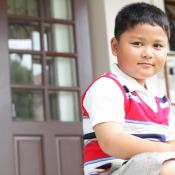 Editor’s note: Dr. Patricia Papernow is a psychologist, an internationally recognized expert on stepfamilies and the author of Surviving and Thriving in Stepfamily Relationships: What Works and What Doesn’t. Patricia’s continuing education presentation for GoodTherapy.org, titled “Meeting the Clinical Challenges of ‘Blended Family’ Relationships” is scheduled for 9 a.m. PDT on May 15, 2015. This event is available at no additional cost to GoodTherapy.org members and is good for two CE credits. For details, or to register, please click here.
Editor’s note: Dr. Patricia Papernow is a psychologist, an internationally recognized expert on stepfamilies and the author of Surviving and Thriving in Stepfamily Relationships: What Works and What Doesn’t. Patricia’s continuing education presentation for GoodTherapy.org, titled “Meeting the Clinical Challenges of ‘Blended Family’ Relationships” is scheduled for 9 a.m. PDT on May 15, 2015. This event is available at no additional cost to GoodTherapy.org members and is good for two CE credits. For details, or to register, please click here.
In some ways, a stepfamily looks like any other family. However, it is critical for therapists to understand that stepfamily structure creates a fundamentally different foundation upon which to build a family. The good news is that several decades of research and practice tell us a great deal about how to make healthy, thriving stepfamilies. The bad news is that many stepfamily members, and all too many clinicians, do not have this information. In fact, many myths and misconceptions may inform stepfamily members’ expectations and their therapists’ recommendations about the “blending” of families. As a result, both stepfamily members and their therapists make some very common “wrong turns” with sometimes devastating results. Here are two of the “easy wrong turns” that I often see, along with some practical, evidence-based guidance about what does work.
Easy Wrong Turn No. 1: “Make the Couple Primary”
Our Western, first-time family model puts the couple at the center of the family—“If the couple is OK, the children will be OK.” Indeed, a good couple relationship is very important for stepfamily health. It is also true that stepfamily structure makes adult stepcouple relationships quite vulnerable: In a first-time family, children enter their parents’ already-established relationship. They are hardwired for attachment to both parents, and vice versa. In contrast, in a stepfamily, the strong, historical pathways to attachment lie in the previously existing parent-child relationships, not in the adult couple. Established agreements about everything from food to noise to mess to money also lie within the parent-child unit, not in the new couple.

Patricia Papernow, EdD
Now add that children need their parents, not their stepparents. Furthermore, while a new couple relationship is a wonderful gift for the adults, children often experience a loss of parental attention and yet another series of unchosen, uncomfortable changes. In fact, very strong stepcouple relationships are linked to poorer well-being in stepchildren, probably because kids are not getting the secure parental attachment that they need. Many children also experience a loyalty bind: “If I care about my stepparent, I have betrayed my parent.” As a result, stepchildren often need distance from their stepparents. Some may even be actively rejecting.
For all of these reasons, every time a child enters the room or becomes the topic of conversation, stepparents find themselves in a stuck outsider position. Parents are stuck insiders. Here’s how it unfolds: Kate, a stepmother, has finally found a moment when she has the full attention of her partner, Joanne. Kate and Joanne are deeply engaged in conversation when Joanne’s daughter, Julia, bursts through the front door. Julia, age 12, has just learned that her “best” friend did not invite her to a sleepover. Julia needs to bring this, and all of the stories from her day at school, to her mom. Not to her stepmom. Julia charges into the house, “Mom, you wouldn’t believe …” What does Joanne do? What does any good parent do? She turns to her daughter. Kate is left standing on the outside.
These kinds of interruptions also happen in a first-time family. However, in a healthy first-time family, insider/outsider positions shift between the adults. Sometimes one parent is the center of the child’s attention. Sometimes it is the other parent. In a stepfamily, insider/outsider positions in the adult couple are stuck. Every time a child enters the room, the stepparent is left out, or even pushed into the outsider position. The parent is pulled into the insider position. Even more painful, insiders and outsiders experience the same moment very differently: Stuck insiders feel pulled, inadequate, and constantly torn, “I turn to my child and my partner is upset. If I turn to my partner, my child is upset.” Stuck outsiders feel alone, invisible, and “like I don’t matter.” Couples expecting blissful blending are especially likely to experience these moments of difference as painfully disappointing attachment breaks. What to do?
What Works: One-to-One Time Strengthens Bonds throughout the Family
The vulnerable adult stepcouple does need focused attention, and time alone without children. Successful stepcouples find moments to turn to each other and reach for each other. If this goes well, later, after Julia is in bed, Kate and Joanne will find some time alone together to reconnect. Kate might be able to say to Joanne, “I could use a hug!” and even, “How is Julia?” Joanne might be able to say to Kate, “I know we left you there. Thanks for leaving space. How you doing?”
However, good therapy for stepfamilies does not stop at strengthening the couple relationship. It is critical to remember that children in a stepfamily also need regular, reliable time alone with their parents. In fact, extremely strong stepcouple relationships are linked to poorer well-being in stepchildren, probably because kids are not getting the parental connection that they need. Secure attachment is the most regulating, comforting, and powerful healing force for children. Julia, for example, needs time with her mom to process her day.
In a stepfamily, the guideline is both/and, not either/or. Successful stepcouples carve out both time alone together and consistent, dependable time for parent-child connection.
While we are on the subject of one-to-one time, stepparents and stepchildren also need some time alone together to build their own new relationship. When the whole stepfamily is together, the stronger, older parent-child relationships trump stepparent-stepchild relationships. I suggest that stepparents look for low-key, enjoyable, “shoulder-to-shoulder” activities they can do with their stepchildren—cook a meal together, go skiing together, build something together, etcetera.
Bottom line: One-to-one time throughout the family supports stepfamily health and well-being. (Note: This also applies to later-life recouplers with adult children.)
Easy Wrong Turn No. 2: “Parents Should Support the Stepparent’s Discipline”
Adults expect to take a disciplinary role in a family. Indeed, some single parents may be longing for help with this task and stepparents may assume that they will step in to discipline their stepchildren and that their partners will back them up. As a result, many stepparents are pulled to exert their authority before they have formed a relationship with their stepchildren. When children “resist,” empathetic parents are in a bind. They often sense that too much is being asked of their children. But if they stand firm, they abandon their children. If they support their kids, the stepparent feels betrayed. Stepparent websites are full of complaints about parents who don’t back up the stepparent’s discipline, “even though we agreed.”An additional challenge is that stepfamily structure polarizes parents and stepparents around parenting tasks. Stepparents usually want more limits and boundaries with their stepchildren. Parents want more love and understanding for their kids. Kate complains that her partner Joanne lets 12-year-old Julia “mouth off.” “I think this is totally unacceptable,” says Kate. Joanne retorts, “Kate doesn’t understand teenagers. I want my daughter to have a voice. I welcome it!”
This polarity is present whether or not both adults have children. Parents not only have that heart connection with their own children, they also have shared understandings about what is “bad behavior.” Stepparents have neither the underlying bedrock of attachment nor agreed-upon rules and values.
When this goes badly, frustrated stepparents become increasingly harsh and parents become increasingly defensive and permissive, and children are caught in the middle. What to do?
What Works: Parents Retain the Disciplinary Role
Beginning with Diana Baumrind’s work (1986), a large body of research clearly tells us that children do best with authoritative parenting. Authoritative parents are warm and responsive, and they provide moderately firm limits. However, the research is also very clear that until or unless stepparents have formed trusting, caring relationships with their stepchildren, parents must retain the disciplinary role (Ganong and Coleman, 2004). Even authoritative discipline by a stepparent, too early, often backfires. Furthermore, across cultures, authoritarian (cold and firm) parenting by a stepparent proves extremely toxic to stepparent-stepchild relationships (Papernow, 2013).
The guideline I give stepparents is to focus on connection not on correction. As my good friend and colleague Beverly Reifman puts it, “You have to make a relationship with your stepkids before you can make any rules.” In fact, there are many healthy thriving stepfamilies where stepparents never take a disciplinary role.
Meanwhile, successful stepcouples do work as a parenting team: Stepparents have input and parents have final say with their own children. When this goes well, stepparents can often help parents become firmer and parents can help stepparents to be more understanding. Joanne may help Kate to appreciate Julia’s feistiness. (This will be especially hard if Kate was raised in an authoritarian family!) Kate may help Joanne to teach her daughter to find some constructive, calm ways to say hard things.
Cultivating a Healthy, Thriving Stepfamily
With patience and wisdom, stepfamilies can become healthy, thriving families and good places for both adults and children. After five years, children in stepfamilies look a lot like children in first-time families. However, becoming a stepfamily is a process, not an event. It takes years, not weeks or months.
Research does tell us that age and gender make a difference: Children under 8 and boys find the transition easier (Van Eeden-Moorefield and Pasley, 2012). Adolescents, particularly early teen girls like Joanne’s daughter Julia, find the adjustment especially difficult. This means that, even in the same family, some children will need more time than others. As one mom said to me, “Becoming a stepfamily is not fast food. It’s a slow cooker!” We can add that some ingredients may need a very long time to brew while others cook more quickly.
References:
- Baumrind, D. (1989). Rearing competent children. In W. Damon (Ed.) Child development today and tomorrow (pp. 349-378). San Francisco, CA: Jossey-Bass.
- Ganong, L., & Coleman, M. (2004). Stepfamily relationships: Development, dynamics, and interventions. New York: Plenum.
- Papernow, P. (2013). Surviving and Thriving in Stepfamily Relationships: What Works and What Doesn’t. New York: Routledge.
- Van Eeden-Moorfield, B., & Pasley, K. (2012). Remarriage and stepfamily life. In G. Peterson & K. Bush (Eds.), Handbook of marriage and the family (3rd ed.) (pp. 517-548). New York: Springer
© Copyright 2015 GoodTherapy.org. All rights reserved.
The preceding article was solely written by the author named above. Any views and opinions expressed are not necessarily shared by GoodTherapy.org. Questions or concerns about the preceding article can be directed to the author or posted as a comment below.

 Blending Families: Five Strategies for the New Stepparent
Blending Families: Five Strategies for the New Stepparent Joint Custody Is Better for Kids' Health, Study Suggests
Joint Custody Is Better for Kids' Health, Study Suggests Everyone’s Happiness Counts: The Single Parent’s Guide to Dating
Everyone’s Happiness Counts: The Single Parent’s Guide to Dating